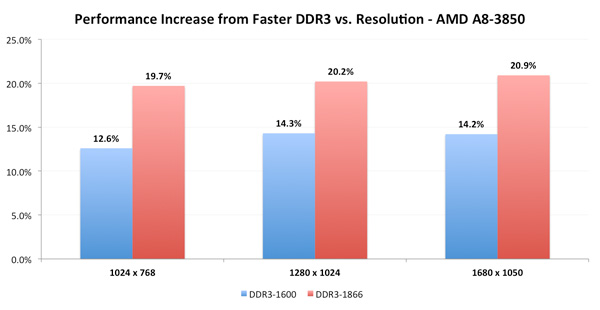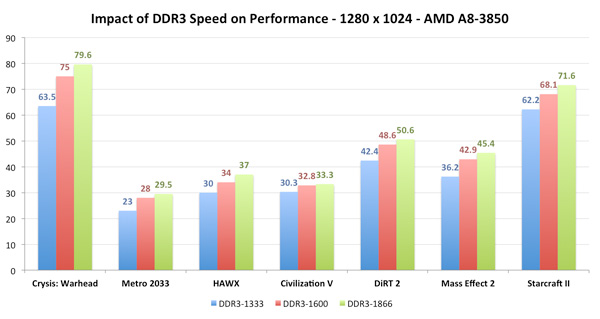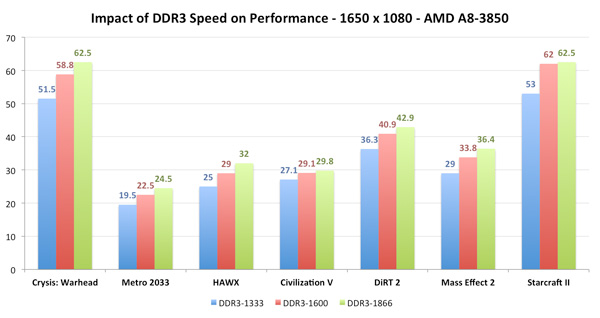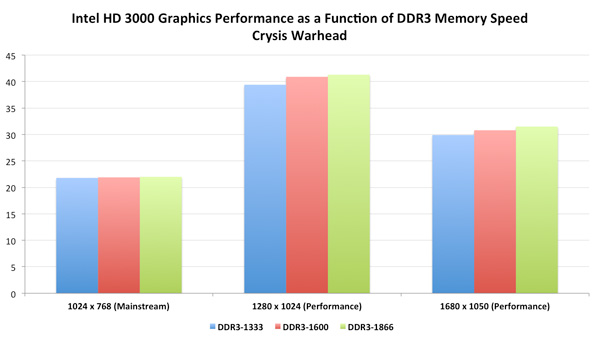The AMD A8-3850 Review: Llano on the Desktop
by Anand Lal Shimpi on June 30, 2011 3:11 AM ESTLlano GPU Performance vs. DDR3 Speed
Desktop Llano processors feature the same dual-channel memory controller as their mobile counterparts. Their memory support however is far more robust. You get a maximum of four DIMM slots on a desktop Llano motherboard (up from two SO-DIMM slots on a mobile Llano), and the chip officially supports memory speeds up to DDR3-1866 (1600 is the limit for mobile Llano). The added memory bandwidth is most useful in feeding the on-die Radeon GPU.
Across our seven titles we found that on average DDR3-1600 resulted in a 12.6% increase in performance over DDR3-1333 at 1024 x 768. Moving up to higher resolutions only increased the advantage by under 2%. Using DDR3-1866 showed around a 20% increase in performance over DDR3-1333.
Note that this is in stark contrast to Intel's Sandy Bridge, which based on our testing does not seem to gain a lot from faster memory:
Although we're just showing Crysis Warhead here as an example, we couldn't find any tangible evidence of performance scaling with faster memory speeds across any of the other titles we tested as well.
With memory pricing being as low as it is these days, it makes the most sense for someone building a Llano machine with intention of gaming to equip it with DDR3-1866 memory. A quick survey of Newegg shows the cheapest price for a 4GB DDR3-1333 or 1600 kit as $35 while 1866 will set you back $60.















99 Comments
View All Comments
Roland00Address - Thursday, June 30, 2011 - link
1366x768 would be preferable than 1024x768, for very few things use 1024x768 anymore, and 1366x768 is the default resolution for 720p tvs, 18.5 inch monitors, and older cheap monitors bought in the last 3 to 4 years.BigDDesign - Friday, July 1, 2011 - link
I like to play games. 1024X768 is useable in a pinch. So bragging is out. Who cares?CSMR - Sunday, July 3, 2011 - link
What do you mean, image quality comparison? If two graphics cards differ in image quality, one of them does not work and needs bug-fixes. So your question is really, are there any bugs in graphics output on this "APU".Unfortunately sites often do "image quality comparisons" but it is nonsense, actually marketing nonsense.
Musafir_86 - Tuesday, July 5, 2011 - link
-Image Quality (IQ) here means the rendered 3D images of 3D games, the latest of them includes Crysis 2, DiRT 3, etc.-In most games, different levels of quality (quality setting like low, medium, high) is provided for scalability reason (so they can cater a wider range of customers).
-Different GPU uses different algorithms/techniques or 'tweaks' to squeeze maximum performance at a given quality metric. So, in applying those tweaks, the rendered output is sometimes different between one another even though the quality level is same (e.g. High vs. High). Driver maturity is also another contributing factor.
-FYI, Anandtech DOES provide IQ comparisons before, especially when comparing new Radeon and GeForce generations.
-BTW, I hope the IQ comparison as promised by Ganesh would be available soon.
Regards.
ckryan - Thursday, June 30, 2011 - link
Like the mobile version, Llano on the desktop is actually kinda impressive. Not necessarily for its current perfomance, but rather as an indication of what to expect from Trinity. With a significant performance boost to both parts of the CPU, I can easily envision my next laptop using Llano's successor.While its impossible not to compare these parts to Sandy Bridge, its not like a Phenom II x4 is hopelessly obsolete. Llano's desktop power figures are pretty good, but it seems like the 2105 draws way more power than it needs at idle -- my i5 2500k/P67 and a GTX 460 pulls 49w from the wall according to my P3 Kill A Watt.
Still, I'm glad to see AMDs fusion initiative paying some dividends. It's good to have options, but I think it's time they stopped playing hard to get with Bulldozer.
L. - Thursday, June 30, 2011 - link
Hey .. I was just thinking, considering the scaling, would you just run those tests again with a decent memory kit ?I mean, most people buying Llano will probably get 1866 at the price of 1600, considering usual RAM market trends (1333 is dead/ price rising - 1600 is bottom price, many kits actually do much more than their SPD - 1866 is bottom within 3 months I guess, etc.).
So, what about some real neat kits @ 2.2+ or even relatively cheap ones around 2Ghz ?
I'm pretty sure that's where Llano will start making sense (or ... with quad-ddr5 .. 8 times the bandwidth should do the trick, right ?)
L. - Thursday, June 30, 2011 - link
I forgot one detail, there is no benchmark showing how that 6550D fares when you add a bit of shiny to your gfx settings, is it really so pitiful noone would ever consider pressing the button ?mino - Sunday, July 3, 2011 - link
i* cannot handle that, so writing such is a big no-no.jjj - Thursday, June 30, 2011 - link
No overclocking section :(I know the ASRock A75 Extreme6 review covers it a bit,but not nearly enough(doesn't even tell us idle voltages)
Was curious to see how it overclocks in a few scenarios:
- with a discrete GPU (IGP fully sleeping)
- with 2 CPU cores disabled (if it is even possible)
- with the GPU starved by limiting the ammount of ram it gets
- how far can it be underclocked
beginner99 - Thursday, June 30, 2011 - link
Marketed for years as being something special (APU) but seriously it's nothing special at all. Intel was 1.5 years earlier (Arrandale). Agreed the power of the igp was pretty bad but still...This is basically only usable in the mobile version. And there it ain't to bad especially in terms of power consumption. Considering AMDs mobile track record in the last couple of year I would say its a pretty good comeback. And this was obviously its main target.